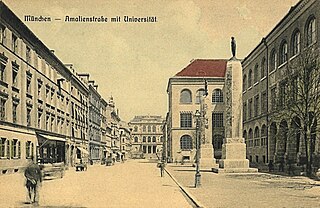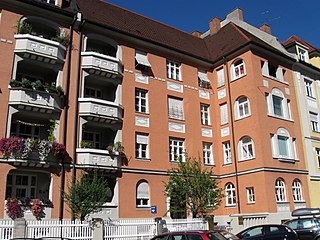
Munich is the capital and most populous city of the Free State of Bavaria. With a population of 1,589,706 inhabitants as of 29 February 2024, it is the third-largest city in Germany, after Berlin and Hamburg, and thus the largest which does not constitute its own state, as well as the 11th-largest city in the European Union. The city's metropolitan region is home to about 6.2 million people and the third largest metropolitan region by GDP in the European Union.

Studentenstadt Freimann is a student housing complex in Munich, Germany.
Freimann or Freiman may refer to:

Milbertshofen, Am Riesenfeld and Am Hart are three boroughs situated in the north of Munich in Germany. Jointly, they form the city district 11 Milbertshofen-Am Hart. As of December 2016, the three boroughs had 76,255 inhabitants.

The Ludwigstraße in Munich is one of the city's four royal avenues next to the Brienner Straße, the Maximilianstraße and the Prinzregentenstraße. The avenue is named after King Ludwig I of Bavaria. The city's grandest boulevard still maintains its architectural uniformity envisioned as a grand street "worthy the kingdom" as requested by the king. The Ludwigstraße has served for state parades and funeral processions.

Countess Fanny "Franziska" zu Reventlow 18 May 1871 – 26 July 1918) was a German writer, artist and translator, who became famous as the "Bohemian Countess" of Schwabing in the years leading up to World War I.

Alfred Schuler was a German classicist, esotericist, ceremonial magician, mystagogue, writer, poet, and independent scholar. He was a co-founder and central esoteric figure of the Munich Cosmic Circle, a prominent group of Munich-based writers and intellectuals. Furthermore, he was a notable influence to poet Stefan George and philosopher Ludwig Klages, of whom he was a life-long friend, as well as other members of the Circle. The majority of his literary output was not published until after his death.

Leopoldstraße is a street in the Munich districts Maxvorstadt, Schwabing and Milbertshofen. It is a major boulevard, and the main street of the Schwabing district. It is a continuation of Ludwigstraße, the boulevard of King Ludwig I of Bavaria, north of the Siegestor.

Schwabinger 7 or Schwabinger Sieben is a tavern in the Feilitzschstraße in the area known as Münchner Freiheit in Munich, Germany. The name comes from the neighbourhood Schwabing and the 7 is the house number of the original establishment.

Munich North is an electoral constituency represented in the Bundestag. It elects one member via first-past-the-post voting. Under the current constituency numbering system, it is designated as constituency 216. It is located in southern Bavaria, comprising the northern part of the city of Munich.

The Nordfriedhof, with 34,000 burial plots, is one of the largest cemeteries in Munich, Bavaria, Germany. It is situated in the suburb of Schwabing-Freimann. It was established by the former community of Schwabing in 1884. It is not to be confused with the Alter Nordfriedhof in Munich, which was set up only a short time previously within the then territory of the city of Munich.

The Café Stefanie was a coffeehouse in Munich which around the 1900s till the 1920s was the leading artists' meeting place in the city, similar to the Café Größenwahn atmosphere of the Café des Westens in Berlin and the Café Griensteidl in Vienna. The cafe was located on the corner of Amalienstraße and Theresienstraße in the Maxvorstadt not far from the Simplicissimus cabaret and Die Elf Scharfrichter. At the time it was one of the few establishments in Munich which stayed open till 3:00 in the morning.

The Ungererstraße is a street about 2.5 km long in the Schwabing district of Munich.
Hohenzollernstraße is a 2 km (1.2 mi) long street in Munich's Schwabing district.
The Feilitzschstraße is a roughly 450-meter-long street in Munich's Schwabing district. After the incorporation of Schwabing to Munich in 1891, it was renamed after the Bavarian State Interior Minister, Maximilian von Feilitzsch (1834–1913) in order to avoid confusion with the Maffeistraße in the old town.

The Belgradstraße is a 2.0-kilometer-long street in Munich's Schwabing district. It runs in a south–north direction between Kurfürstenplatz and Petuelpark, where it merges into Knorrstraße. The street was named after the Serbian capital Belgrade.

Clemensstraße is a 1.76-kilometer-long street in Munich's Schwabing district. The street, named after Clemens August of Bavaria (1700–1761), labeled under the term Green Axis Schwabing is a participative model project for all Munich municipalities and Munich's longest bicycle road.

Kurfürstenplatz is a square in the Munich district of Schwabing and is located about two and a half kilometres north of the city centre. It is the intersection of several streets and tram lines and was built in 1915 and named after the Elector Maximilian II. Emanuel, born in Munich in 1662.

The Campus Garching is a campus of the Technical University of Munich and a number of other research institutes, located around 10 km north of Munich in Garching. At the same time, it constitutes a district of the city. With more than 7,500 employees and around 17,000 students, it is one of the largest centers for science, research and teaching in Germany.



















